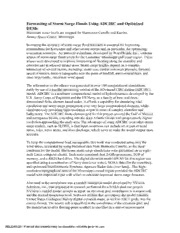
NASA Technical Reports Server (NTRS) 20060006659: Forecasting of Storm Surge Floods Using ADCIRC and Optimized DEMs PDF
Preview NASA Technical Reports Server (NTRS) 20060006659: Forecasting of Storm Surge Floods Using ADCIRC and Optimized DEMs
Forecasting of Storm Surge Floods Using ADCIRC and Optimized DEMs Maximum water levels are mapped for Hurricanes Camille and Katrina. Stennis Space Center, Mississippi Increasing the accuracy of storm surge flood forecasts is essential for improving preparedness for hurricanes and other severe storms and, in particular, for optimizing evacuation scenarios. An interactive database, developed by WorldWinds, Inc., contains atlases of storm surge flood levels for the Louisiana/ Mississippi gulf coast region. These atlases were developed to improve forecasting of flooding along the coastline and estuaries and in adjacent inland areas. Storm surge heights depend on a complex interaction of several factors, including: storm size, central minimum pressure, forward speed of motion, bottom topography near the point of landfall, astronomical tides, and most importantly, maximum wind speed. The information in the atlases was generated in over 100 computational simulations, partly by use of a parallel-processing version of the ADvanced CIRCulation (ADCIRC) model. ADCIRC is a nonlinear computational model of hydrodynamics, developed by the U.S. Army Corps of Engineers and the US Navy, as a family of two- and three- dimensional finite element based codes. It affords a capability for simulating tidal circulation and storm surge propagation over very large computational domains, while simultaneously providing high-resolution output in areas of complex shoreline and bathymetry. The ADCIRC finite-element grid for this project covered the Gulf of Mexico and contiguous basins, extending into the deep Atlantic Ocean with progressively higher resolution approaching the study area. The advantage of using ADCIRC over other storm surge models, such as SLOSH, is that input conditions can include all or part of wind stress, tides, wave stress, and river discharge, which serve to make the model output more accurate. To keep the computational load manageable, this work was conducted using only the wind stress, calculated by using historical data from Hurricane Camille, as the input condition for the model. Hurricane storm surge simulations were performed on an eight- node Linux computer cluster. Each node contained dual 2-GHz processors, 2GB of memory, and a 40GB hard drive. The digital elevation model (DEM) for this region was specified using a combination of Navy data (over water), NOAA data (for the coastline), and optimized Interferometric Synthetic Aperture Radar data (over land). This high- resolution topographical data of the Mississippi coastal region provided the ADCIRC model with improved input with which to calculate improved storm surge forecasts. Also used in the simulations was a rainfall inundation model developed by NVision Solutions, Inc., that originated in research performed for a NASA dual-use project. NVision’s rainfall model accepts as input: an elevation grid, coordinates to a source cell, and the desired inundation level. Software utilities that accompany the model translate United States Geological Survey digital elevation maps, as well as ASCII grids, into the correct format. The source cell is specified in the coordinates of the elevation grid, and the inundation level (a floating-point number) is specified in a unit of measurement RREELLEEAASSEEDD -- PPrriinntteedd ddooccuummeennttss mmaayy bbee oobbssoolleettee;; vvaalliiddaattee pprriioorr ttoo uussee.. compatible with that used for the input elevation. The rainfall simulations were performed for various hurricane landfall scenarios that included different intensities, storm sizes, forward speeds, and landfall locations. Typically, each hurricane simulation, started 3 days of simulated time before Camille landfall, took about 5 hours of computing time in parallel processing on all sixteen processors. The results of the ADCIRC and rainfall simulations were composited to determine the highest storm-surge value possible for each grid node; the resulting maps are known as maximum envelope of water (MEOW) maps. Figure 1 shows the maximum storm surge for a Category 3 storm in the vicinity of the back bay of Biloxi, MS. The maximum storm surge is approximately 20 feet inside the bay. Over most of the bay area, the storm surge varies between 15 feet and 25 feet. Ground measurements at various discrete locations (Simpson et al. 1970, Robert 1969) during Hurricane Camille show that a maximum storm surge of over 22 feet occurred at Pass Christian, MS, west of Biloxi. Emergency planners and local government officials make public evacuation plans based on MEOW maps. Figure 2 depicts WorldWinds' ADCIRC computer model simulation of Hurricane Katrina's storm surge, showing a 25-30 foot wall of water, pushed by 140-mph winds, slamming into the Louisiana/Mississippi Gulf Coast. The maximum surge from Katrina is higher than Camille, and covered a wider region, even though the intensity of the surge was slightly less. This happened because Katrina’s strong winds covered a larger area and Katrina moved more slowly than Camille, allowing more time for the water to accumulate. WorldWinds has provided technical support and parallel computing resources to the Louisiana Department of Natural Resources, URS Corporation, and NASA, to model hurricane storm surge flooding in southeastern Louisiana and along the Mississippi Gulf Coast. This work was done by Elizabeth Valenti and Patrick Fitzpatrick of WorldWinds, Inc. for Stennis Space Center. Inquiries concerning rights for the commercial use of this invention should be addressed to the Intellectual Property Manager, Stennis Space Center, (228)688-1929. Refer to SSC-00229. RREELLEEAASSEEDD -- PPrriinntteedd ddooccuummeennttss mmaayy bbee oobbssoolleettee;; vvaalliiddaattee pprriioorr ttoo uussee.. Figure captions: (2 columns) Figure 1. This MEOW Map shows the maximum storm surge at each finite-element node based on all simulations of category-3 hurricanes in the affected area. Figure 2. ADCIRC calculated storm surge heights for Hurricane Katrina on Monday, August 29 at 11a local time. This image shows a 25-30 foot storm surge in the Bay St. Louis and Pass Christian communities. RREELLEEAASSEEDD -- PPrriinntteedd ddooccuummeennttss mmaayy bbee oobbssoolleettee;; vvaalliiddaattee pprriioorr ttoo uussee.. RREELLEEAASSEEDD -- PPrriinntteedd ddooccuummeennttss mmaayy bbee oobbssoolleettee;; vvaalliiddaattee pprriioorr ttoo uussee..
